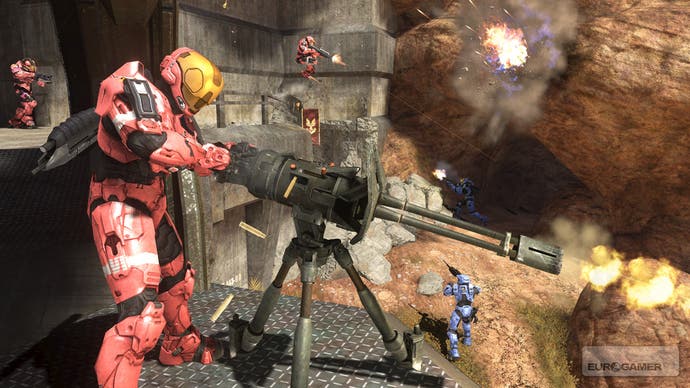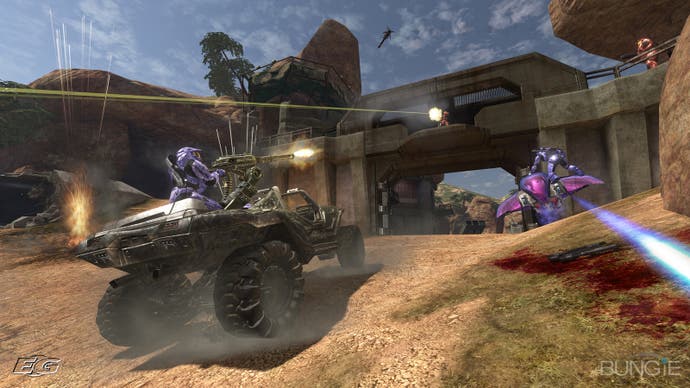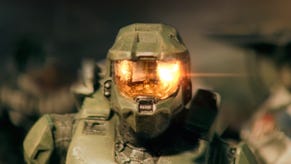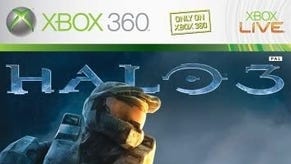So far, so good.
The fight, finished.
Destination Earth
So far, so good; you could, if you were trying to review this game in a 200 word box in a newspaper, probably reduce the last section to "more of the same, but with some well considered tweaks which we like a lot". On the strength of Halo 2, that alone should guarantee a copy in the hands of every first-person shooter fan on the planet.
However, that doesn't really touch on the real meat of why Halo 3 is a better game than its predecessor. Like we said earlier, Halo 2's failings weren't in its fundamentals - they lay, rather, in the context. So while Halo 3 certainly tweaks, polishes and buffs up the fundamentals, where it really sets itself apart is in that all-important context.
The narrative, for example, flows through the game smoothly and efficiently, delivering revelations with practised grace. The player is pushed from encounter to encounter with a clear view of what you're doing, why you're doing it and how you should go about it. At its best, the game's superb use of marine chatter, radio communications and scripted events give you the genuine sense of being a key player in a much wider war effort. Even at its weakest, when it falls back on traditional cutscenes, Halo 3 is rarely short of dramatic.
In the interests of a spoilter-free review, we're not going to discuss the plot - but it's worth mentioning that one story aspect doesn't survive the gap between Halo 2 and Halo 3. The Arbiter, the second playable character in Halo 2, sees his storyline all but eliminated from the final game in the trilogy. He is reduced to the role of an AI-controlled NPC, fighting alongside you on several missions - while the personality clash between the Arbiter and the Master Chief, built up so well in Halo 2, is reduced to one pointlessly brief scene. Playing as the Arbiter was an unpopular decision in Halo 2, perhaps because the "noble enemy" role sullied the straightforward, gung-ho nature of the rest of the narrative; but it still jars a little to see an interesting storyline fizzle out like this. Only a little, though.

Voiceovers, a key part of delivering the narrative experience, are universally superb - and occasionally laugh out loud funny, with your fellow marines delivering plenty of lines that are heavily influenced by online gaming culture. The music, too, is downright excellent, and perhaps even more bombastic and energetic than the game's previous symphonic scores. The distinctive Halo themes are woven throughout the most epic combat sequences, setting our spines - and subwoofers - tingling with anticipation throughout.
Graphically, however, the game is impressive only in a muted sense. Here, too, comparisons with Halo 2 will be made, and justifiably so - Halo 3 feels very much like an improved version of the Halo 2 engine, not a cutting edge next-generation visual feast. The primary technical improvements are not graphical enhancements - although higher definition textures, lovely sky animations and lengthy vistas can combine to form impressive scenes in places.
Instead, the focus appears to have been on making sure everything runs smoothly throughout - taking the Halo 2 engine, which regularly pushed against the constraints of the Xbox hardware, and giving it room to breathe on the vastly superior Xbox 360 platform. Texture pop-in is a thing of the past, spotted only a handful of times in our play through the campaign. The framerate, both online and offline, is so smooth and steady you could rest your pint on it.

We sense the influence of multiplayer - with its requirement for consistent framerate and a level playing field - in many of the graphical decisions Bungie has made. It's not that the game is ugly - well, aside from the human faces perhaps, which look flat and unnatural and are the most obvious relics of the last generation here. For the most part, though, the art direction is superb, with a huge range of different visually unique levels and environments to fight through.
It's just that, compared to games like last year's Gears of War, Halo 3 is an underachiever in graphical terms - but to our minds, any negative here is easily cancelled out by the joy of high framerates, no loading delays and an almost complete lack of any graphical glitches. It may not be gold, but it's the most perfectly polished silver we've seen.
















